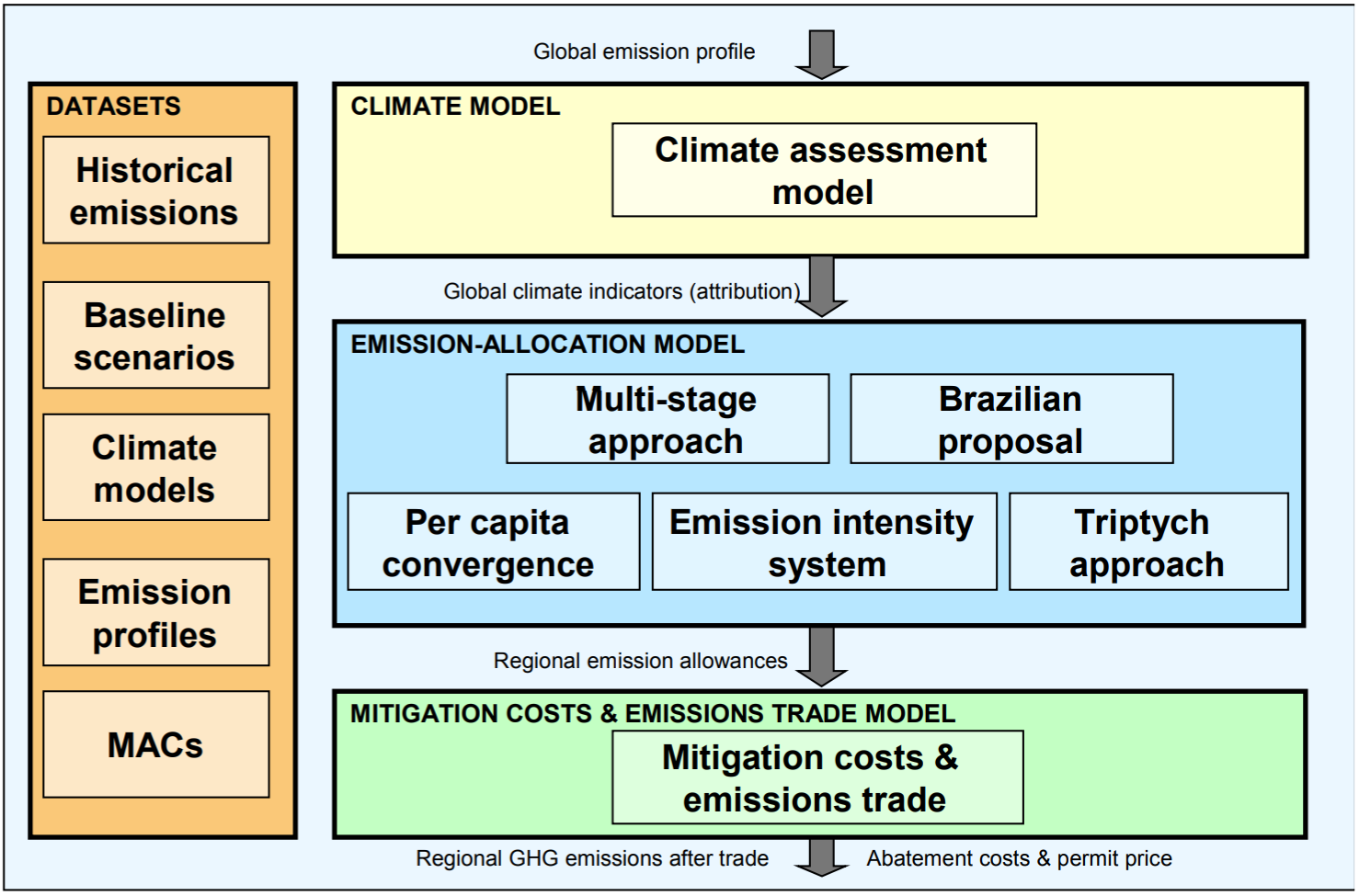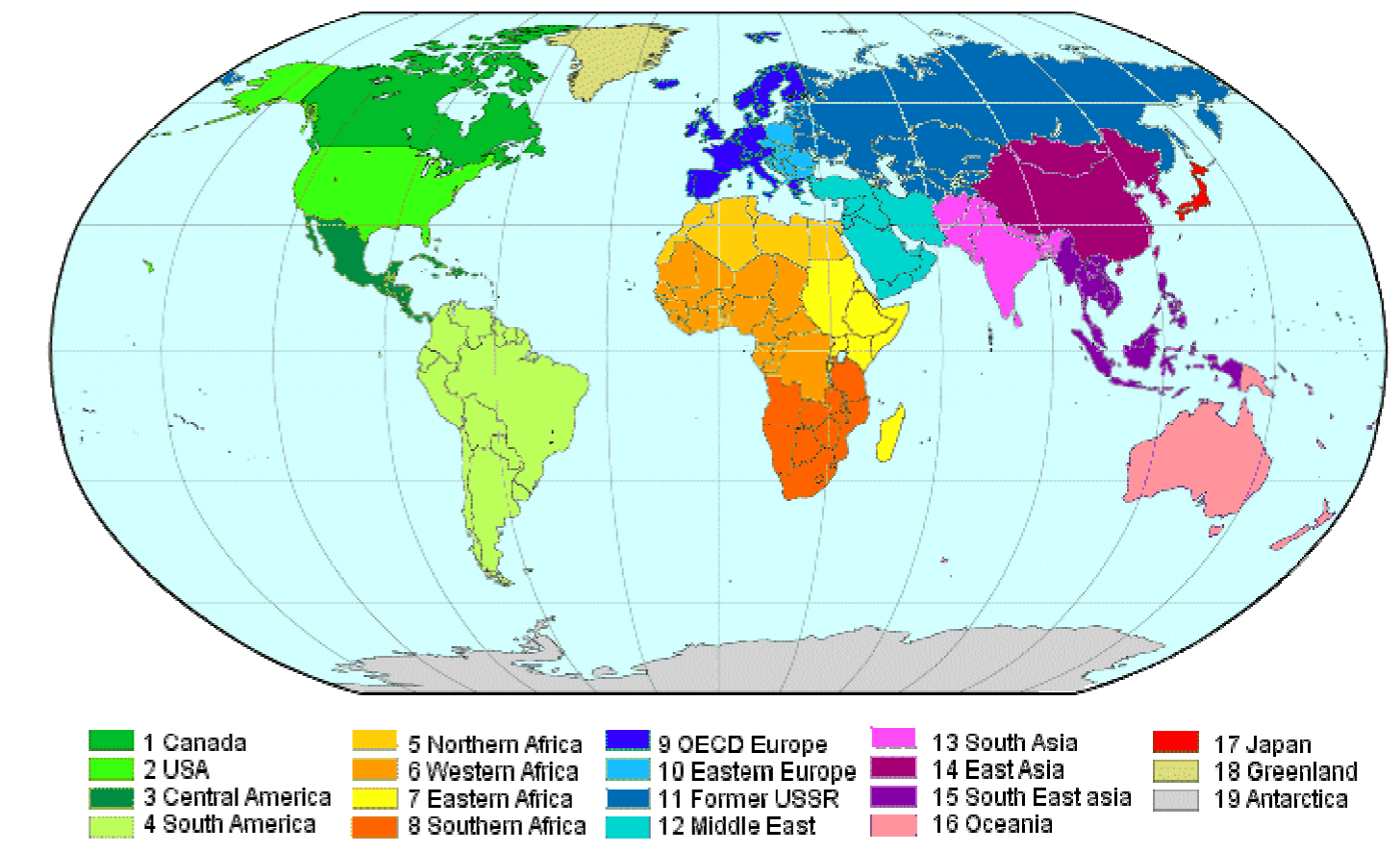Quoted from: https://www.pbl.nl/en/publications/FAIR_2_0_-_A_decision-support_tool_to_assess_the_environmental_and_economic
The FAIR 2.0 model consists of three sub-models as outlined below − a simple climate model, an emission allocation model and a mitigation costs and emissions trade model (Figure 2.1):
1. The climate model calculates the greenhouse gas concentrations, radiative forcing of GHGs and other reactive gases (aerosols), global temperature increase, rate of temperature increase, as well as the sea-level rise for the global emission scenarios and GHG emission profiles associated with different levels of GHG concentration stabilisation targets. A special climate attribution submodel calculates the regional contribution to global temperature increase and other climate indicators on the basis of the effect of their historical emissions.
2. The emission allocation model calculates regional emission allowances for ten future commitment approaches, divided into five groups:
a. The Multi-Stage approach: a top-down approach3 with a gradual increase in the number of countries involved and their level of commitment according to participation and differentiation rules, such as per capita income or per capita emissions (Berk and den Elzen, 2001). A more simplified Multi-stage approach is included here too, with fewer stages and policy variables, and with threshold levels based on the so-called Capability-Responsibility index (den Elzen et al., 2003a).
b. The Brazilian Proposal approach: a top-down approach allocating emission reductions on the basis of contribution to global temperature increase combined with an income threshold for participation for the non-Annex I regions (den Elzen et al., 1999).
c. Convergence approaches: top-down approaches in which emission allowances are calculated on the basis of convergence rules. Four types of convergence regimes are included:
(i) 'Contraction & Convergence', or Per Capita Convergence, i.e. emission allowance convergence towards equal per capita emissions (Meyer, 2000);
(ii) CSE convergence: the Contraction & Convergence approach with basic sustainable emission rights, as introduced by the Centre of Science and Environment (CSE) (CSE, 1998);
(iii) Preference Score approach: a combination of the grandfathering entitlement method and a per capita convergence approach (Bartsch and Müller, 2000).
(iv) Multi-criteria convergence: distribution of commitments based on different weighting of criteria (population, GDP and emissions).
d. Emission intensity system approaches: the emission intensity of the economy is the emissions per unit of economic activity expressed in Gross Domestic Product (GDP). Three types of emission intensity systems are included:
(i) Emission Intensity Convergence approach: a top-down approach with convergence of emission intensities;
(ii) Emission Intensity Targets approach: a bottom-up approach, in which all regions adopt GHG intensity targets right after 2012 when achieving an income threshold.
(iii) Jacoby Rule approach: a bottom-up approach, in which both participation and emission reductions depend on the per capita income (Jacoby et al., 1999). This approach can also be applied top-down by scaling total emissions in the direction of the emission profile.
e. Triptych approach: a sector and technology-oriented bottom-up approach in which overall emission allowances are determined by applying various differentiation rules to different sectors (e.g. convergence of per capita emissions in the domestic sector, efficiency and de-carbonisation targets in the industrial and the power generation sector) (Blok et al., 1997; Phylipsen et al., 1998).
3. The mitigation costs and emissions trade model calculates the tradable emission permits, the international permit price and the total abatement costs, with or without emission trading, according to the regional emission allowances of a certain climate regime. The model makes use of Marginal Abatement Cost curves (MACs) used to derive permit supply and demand curves under different regulation schemes in any emissions trading market using the same methodology as Ellerman and Decaux (1998).

Figure 2.1. Schematic diagram of FAIR 2.0 showing its framework and linkages.
New elements of FAIR 2.0
Since 2001, the FAIR 1.0 model (den Elzen et al., 2001) has undergone numerous major and minor modifications, with several new elements being introduced, leading to the present FAIR 2.0 model. These new elements are briefly summarised here:
1. An increase in the number of world regions – from 13 to 17 – in line with the IMAGE 2.2 world regions. These are Canada, USA, Central America, South America, Northern Africa, Western Africa, Eastern Africa, Southern Africa, OECD Europe, Eastern Europe, Former USSR (FSU), Middle East, South Asia (including India), East Asia (including China), South East Asia, Oceania and Japan (see Figure 2.2).
2. All emission allocation and cost calculations now at the level of CO2-equivalent emissions instead of (fossil) CO2-only.
3. Historical emission datasets now based on the latest EDGAR-HYDE 1.4 historical emissions database (all GHGs and other reactive gases), with the energy and industryrelated CO2 emissions, and the land-use-related CO2 emissions, based on the latest CDIAC-ORNL database.
4. The set of baseline emission scenarios updated with the new IMAGE 2.2 IPCC SRES emission scenarios (IMAGE-team, 2001), along with the original IPCC SRES scenarios (Nakicenovic et al., 2000). The recently developed Common POLES-IMAGE (CPI) emission scenario is also included.
5. Inclusion of new IMAGE 2.2 emission profiles, stabilising the atmospheric CO2- equivalent concentrations7 at different levels (550, 650 and 750 ppmv) (Eickhout et al., 2003).
6. Replacement of the climate model by the stand-alone IMAGE 2.2.version of the Atmosphere-Ocean System (AOS). For alternative climate calculations, the climate model also includes alternative simple carbon-cycle and climate models of the UNFCCC, along with the Impulse Response Functions (IRFs) based on simulation experiments with nine general circulation and other climate models.
7. Improvement of the climate ‘attribution’ module for calculating the regional contributions to global climate indicators using the recent UNFCCC methodology.
8. An updated Triptych approach methodology, including all GHG emissions, as well as improvements to the convergence regime. New climate regimes like Global Compromise, Jacoby rule and different emission intensity systems are also included.
9. Extension of the Multi-Stage regime with a new participation threshold based on both per capita income and per capita emissions, called the Capability-Responsibility (CR) index (den Elzen et al., 2003a). Other new elements include: (i) accounting for a policy delay between passing thresholds and taking action; (ii) using a reference period for calculating threshold levels and (iii) making income-dependent GHG intensity improvements in stage 2.
10. The new mitigation costs and emissions trade model used to analyse the economic implications of a future commitment regime under different emission trading markets.
11. The possibility of evaluating the Kyoto Protocol and its flexibility; the implementation of US intensity targets.

Figure 2.2. The seventeen IMAGE 2.2 world regions (IMAGE-team, 2001) .









